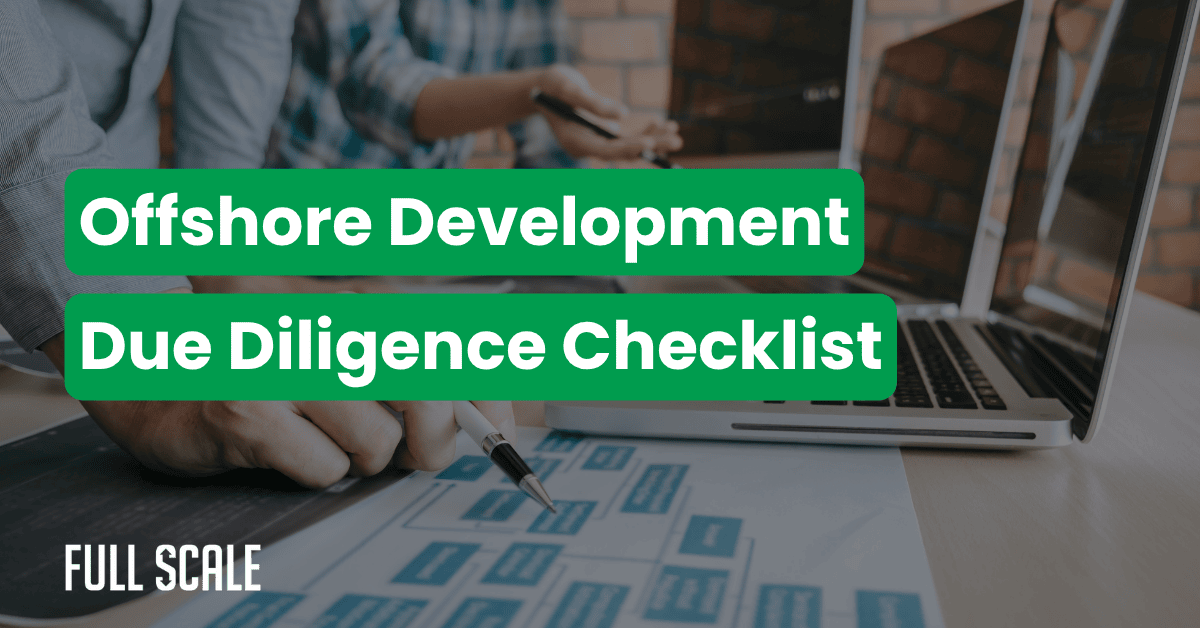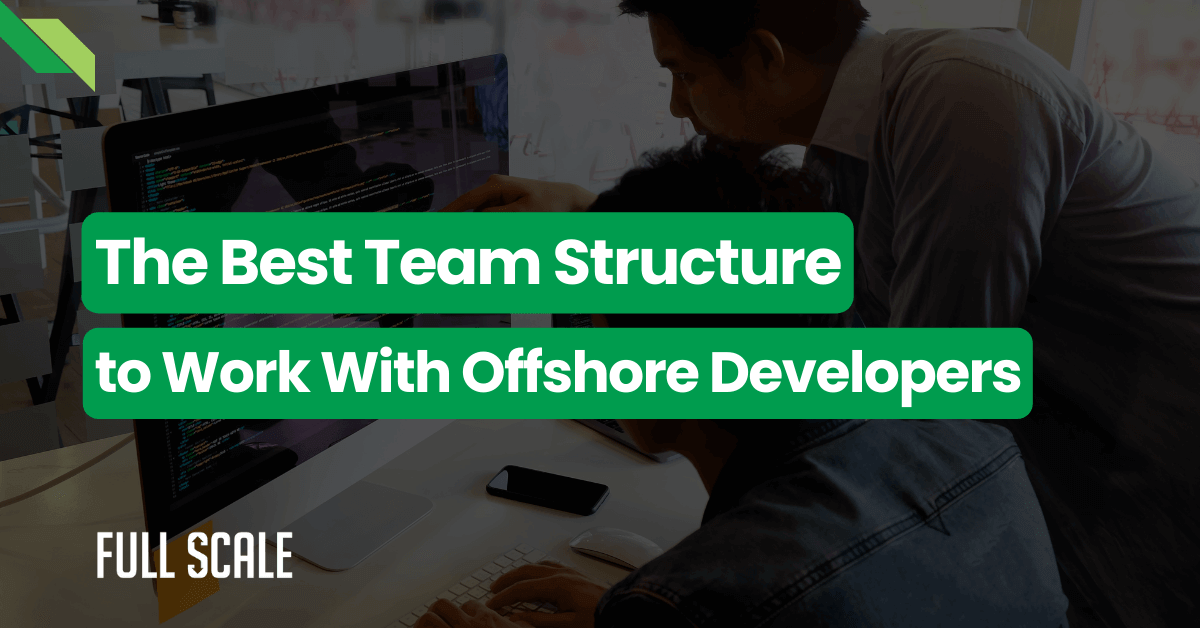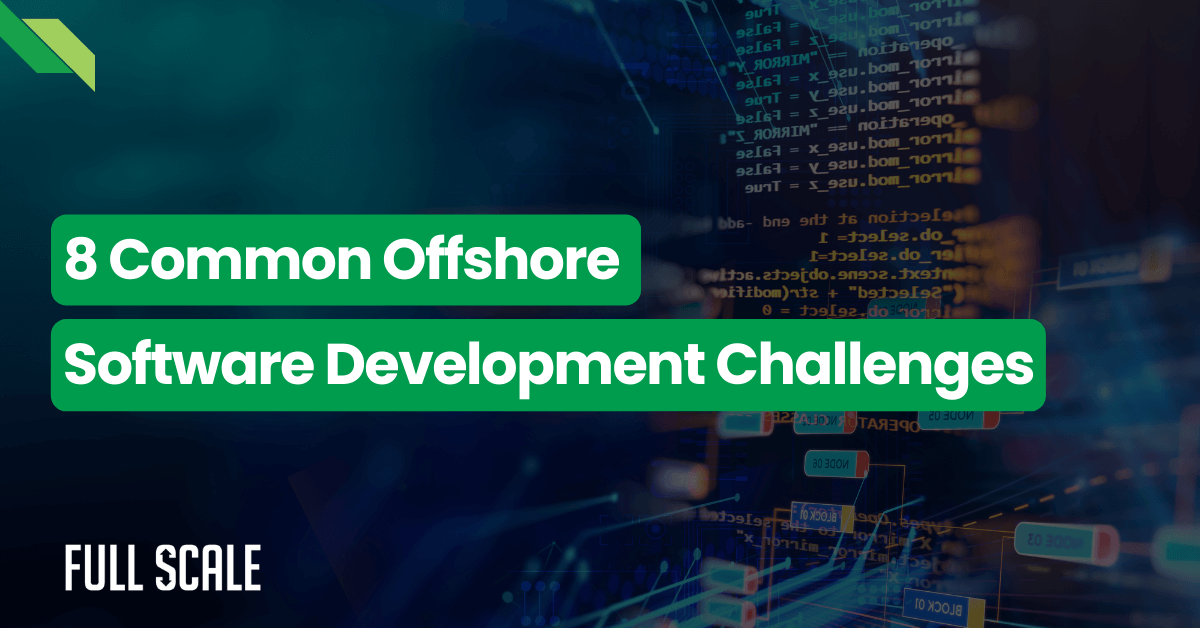Last Updated on 2025-11-10
Here’s the problem with most offshore development due diligence: You’re asking the wrong questions.
You ask, “How many developers do you have?” They answer, “Over 500!” You feel reassured.
But here’s what you should have asked: “What’s your developer retention rate over 3 years?” Watch them squirm.
I learned this the hard way. Back in 2015, I hired an offshore team that checked every box on paper. Senior developers, competitive rates, great references.
Six months and $180K later, I had code that didn’t work. The “senior” developer had 18 months of experience. Every question took 3 days because of the project manager’s buffer.
That disaster led to Full Scale. And this offshore development due diligence checklist.
Most offshore companies survive on high turnover. They churn developers, churn clients, and definitely don’t want you asking questions that expose it. So let’s fix your offshore development due diligence process.
According to a 2024 Deloitte study, 59% of companies reported dissatisfaction with their offshore partnerships. The reason? They evaluated based on cost and size, not the factors that actually predict success.
When evaluating offshore development companies, assess these 8 critical areas: company stability, developer quality, communication model, legal protection, pricing transparency, cultural fit, security measures, and scalability. Each category requires specific verification questions to cut through marketing claims.
📋 What You'll Get From This Guide
8-Category Framework
Specific questions that expose vendor BS before you sign
True Cost Calculator
Reveals hidden fees that vendors conveniently forget
Red Flag Detection
Dealbreakers that predict failure rates above 70%
Answer Examples
What good responses actually sound like vs. rehearsed BS
Why Most Offshore Development Due Diligence Fails
Every offshore company has a polished website. They all claim to be senior developers. They promise seamless communication.
And they’re all saying the exact same thing.
The problem isn’t that you’re not doing research. The problem is you’re asking questions they’ve trained their sales team to handle. You need questions that reveal what they don’t want you to know.
I’ve seen CTOs spend weeks evaluating offshore development companies, only to discover 6 months later that everything they were promised was fiction. The developers weren’t senior. The communication wasn’t seamless. The retention rate was terrible.
This framework changes that. It’s designed to expose BS before you sign a contract. Proper offshore development due diligence saves you from expensive mistakes that cost six months and a significant budget.
The 8-Category Framework for Offshore Development Due Diligence
This table shows what matters when vetting offshore software companies. Most checklists focus on surface-level questions. This framework digs into factors that actually predict success or failure in your offshore development due diligence efforts.
| 📊 Category | 🎯 Why It Matters | ❓ Key Questions |
|---|---|---|
| 🏢 Company Stability | Predicts if they'll exist in 2 years | 3-year client retention rate |
| 👨💻 Developer Quality | Separates senior talent from juniors | Technical vetting process |
| 💬 Communication Model | Determines real integration level | Direct access vs. middlemen |
| ⚖️ Legal Protection | Protects your IP and investment | Contract jurisdiction location |
| 💵 Pricing Transparency | Reveals hidden costs upfront | Total cost breakdown |
| 🌍 Cultural Fit | Affects daily collaboration | Working hours overlap |
| 🔒 Security Measures | Protects sensitive data | Compliance certifications |
| 📈 Scalability | Supports future growth | Talent pipeline depth |
Let’s break down each category with specific questions. These are designed to get past rehearsed sales pitches and reveal actual operational reality.
Category 1: Company Stability and Track Record
This is where most offshore development due diligence starts wrong. People ask, “How long have you been in business?” That’s the wrong question.
Critical Questions to Ask:
- What’s your 3-year client retention rate? Demand a specific number.
- Can you provide 5 references from clients who’ve worked with you for over 2 years?
- What’s your average client relationship length? If it’s under 18 months, that’s a red flag.
Good answers sound like this: “Our 3-year retention is 87 percent. Here are 8 references, all over 2 years.” Bad answers sound like this: “We focus on building long-term partnerships.” That’s corporate speak for terrible retention.
According to Clutch’s 2024 research, the average offshore relationship lasts only 14 months. If they’re beating that significantly, they’re doing something right.
Category 2: Developer Quality and Vetting Process
Everyone claims they have senior developers. Cool story. Prove it.
This visualization shows the developer vetting funnel that separates quality partners from volume shops:

The funnel shows acceptance rates that matter. Quality partners are selective. Volume shops need bodies to fill seats.
Critical Questions for How to Vet Offshore Developers:
- Walk me through your exact technical screening process. I want steps, not buzzwords.
- Can I interview 3 developers before signing anything? If they say no, end the conversation.
- What percentage of applicants pass your screening? If it’s over 15 percent, their bar is too low.
Here’s the reality: If they won’t let you talk to actual developers before commitment, they’re hiding something. Full stop. Learn more about how to build remote development teams effectively.
Category 3: Communication and Integration Model
This is where the rubber meets the road for choosing an offshore development partner’s success. And where most companies hide their biggest flaw: middlemen.
Critical Questions:
- Will I have direct Slack or Microsoft Teams access to my developers? Not their manager, the actual developers.
- Can developers attend our daily standups and sprint planning? If there’s a project manager buffer, that’s a problem.
- What’s the average response time for developer questions? Measure in hours, not days.
Here’s what good looks like: Your offshore developers are in your Slack. They’re in your standups. They commit directly to your GitHub. They’re indistinguishable from your local team except for the time zone.
Here’s what bad looks like: You email a project manager. They relay it to developers. Developers respond to the PM. PM emails you back. You’ve just added 48 hours to every conversation.
Category 4: Legal Protection and Contract Structure
This is where you protect yourself when things go wrong. And trust me, you want this locked down before you need it. Proper offshore development due diligence includes legal verification.
Critical Questions:
- Is the contract governed by US law? If it’s governed by laws in its country, you have no leverage.
- Who owns the IP? It should be you, immediately upon creation, not after payment.
- What’s your NDA structure? They should sign yours, not the other way around.
A 2024 survey by Accelerance found that 34% of companies experienced IP disputes with offshore partners. Every single one of those disputes involved unclear contract terms or foreign jurisdiction.
This matters more than you think. When there’s a problem, you want to be able to enforce agreements in a US court. Otherwise, good luck.
Category 5: Pricing Transparency and Contract Terms
Here’s where you find the hidden costs. Every offshore company advertises a low hourly rate. Few tell you about the extras.
Use this calculator to understand your true offshore development contract checklist costs. It reveals expenses that most vendors conveniently forget to mention.
💰 True Cost Calculator
Most vendors quote hourly rates but hide setup fees, management overhead, and turnover costs.
Calculate your real total investment below.
📈 First Year Investment Breakdown
This is what you actually pay per hour when all costs are included. Compare this to the quoted rate above.
The calculator reveals the real numbers. That attractive hourly rate? It’s probably 30-40 percent higher once you factor in hidden costs.
Compare that to Full Scale’s transparent pricing, where all costs are broken down upfront. No surprises. No hidden fees.
Categories 6-8: Cultural Fit, Security, and Scalability
Cultural and Operational Fit requires at least 4 hours of daily time zone overlap. Developers need the ability to work their core hours when needed. Ask about their asynchronous communication system.
Security and Data Protection demands SOC 2 and ISO 27001 certifications at a minimum. Verify VPN access, 2FA requirements, and device management protocols. Request their incident response plan in writing.
Scalability and Long-Term Growth mean a 2-3 week timeline to add developers, not 2-3 months. They should have pre-vetted talent ready. The replacement process must be defined with guaranteed timelines.
Offshore Development Red Flags That Should End the Conversation
These are dealbreakers. If you see any of these offshore development red flags, walk away. I don’t care how good the sales pitch sounds.
This diagram shows the red flags that predict offshore partnership failure:

Each red flag predicts problems. Multiple red flags predict disaster. Here’s what each means:
- Vague Retention Answers – They don’t want you to know the real number. And guess what? They’re lying about it being good.
- No Direct Developer Access – Hiding developer quality or maximizing billable hours through middlemen.
- Offshore-Only Contracts – You have zero leverage when things go wrong.
- Opaque Pricing – Surprise! You’re about to get an invoice you didn’t expect.
- No Pre-Contract Interviews – Those developers aren’t senior. They might not even be competent.
- Can’t Provide Recent References – Their recent clients aren’t happy.
- Long Minimum Commitments – They expect you to want out. Why else lock you in?
- Unclear IP Ownership – Your code should be yours. Immediately. Forever.
How to Use This Offshore Development Due Diligence Process
Here’s your action plan for implementing proper offshore development due diligence. This is how to evaluate software development vendors properly:
🔍 Step 1: Initial Screening – Use the first 5 categories as knockout questions. If they fail any, stop there.
📞 Step 2: Reference Checks – Ask those references for other clients. The ones they didn’t give you are more honest.
💻 Step 3: Developer Interviews – Talk to at least 3 developers. Ask technical questions and about their company experience.
📄 Step 4: Contract Review – Have your lawyer focus on IP ownership, termination clauses, and jurisdiction.
🧪 Step 5: Pilot Project – Start small. One or two developers for 3 months before scaling.
This process takes time. That’s the point. Rushing offshore development due diligence costs more than the time you save.
What Our Data Shows About Offshore Success
We’ve analyzed 500+ offshore placements over 7 years at Full Scale. Here’s what predicts success:
Success Predictors:
- Direct communication access: 3.2x higher satisfaction
- Month-to-month contracts: 2.7x longer relationships
- Pre-contract developer interviews: 89% better quality perception
- US-based jurisdiction: Zero contract disputes vs. 34% industry average
- Retention above 85%: 4.1x likelihood of long-term partnership
These numbers drove every decision in our model. We built Full Scale to maximize success predictors and eliminate failure modes.
What Good Answers Actually Sound Like
Most vendors have trained responses. Here’s how to tell real quality from rehearsed BS when asking questions to ask offshore development company representatives.
❓ Question: "What's your developer retention rate?"
✅ Good Answer:
"Our 3-year retention is 87 percent. Last year was 91 percent. Here's why we think we do better than average."
❌ Bad Answer:
"We have excellent retention and focus on developer satisfaction."
❓ Question: "Can I have direct access to developers?"
✅ Good Answer:
"Yes, they'll be in your Slack, your standups, everything. No middlemen."
❌ Bad Answer:
"We have a communication structure that ensures quality."
❓ Question: "What's your technical vetting process?"
✅ Good Answer:
"Resume screen, technical test, live coding session, architecture discussion. About 2 percent pass. Here's the breakdown."
❌ Bad Answer:
"We have a rigorous multi-step process that ensures quality."
See the difference? Specifics vs. buzzwords. Numbers vs. platitudes.
Why Partner With Full Scale
We built Full Scale specifically to pass every item on this offshore development due diligence checklist. Here’s how we stack up when you’re evaluating what to look for in offshore partner selection:
- ✅ 95% 3-year retention rate – We treat developers like employees, not contractors
- ✅ US-based contracts – All agreements governed by US law in your favor
- ✅ Direct developer access – Your Slack, your standups, zero middlemen
- ✅ Month-to-month agreements – No long-term lock-ins or hidden fees
- ✅ Pre-contract interviews – Talk to developers before you commit
- ✅ Transparent pricing – All costs broken down at fullscale.io/pricing
- ✅ 3% acceptance rate – We’re selective about who we hire
- ✅ 2-week placement timeline – Fast scaling without sacrificing quality
We’re not perfect for everyone. But if this checklist matters to you, we designed our entire model around it. Learn more about our staff augmentation services.
Developer retention rate predicts everything else. If developers stay, the company treats them well, pays competitively, and has good management. High retention means quality.
Low retention means constant knowledge loss, training overhead, and inconsistent quality. Ask for specific 3-year retention numbers. Anything below 70% is a red flag.
Expect 3-4 weeks for a thorough evaluation. One week for initial research and screening calls. One week for reference checks and developer interviews. One week for contract review and pricing analysis.
Rushing this process costs more than the time you save. A bad offshore partner costs 6 months and a significant budget.
Ask about retention rates with specific numbers. Request direct developer access without project managers. Verify contract jurisdiction and IP ownership. Demand transparent pricing breakdowns, including all fees.
These questions reveal operational reality vs. sales promises. If their answer is “trust us,” that’s your answer. Run.
Request documentation for every claim. Verify retention rates through client references. Confirm certifications through issuing organizations. Review actual contracts, not sales proposals. Interview current clients about their experience.
Talk to developers directly about their tenure. Check the company’s financial stability through business databases. Trust but verify everything.
It depends on your priorities. Local hiring offers easier collaboration but costs 2-3 times more. Quality offshore partners provide senior talent at lower costs with proper vetting.
The key is choosing an offshore development partner with the right model. Staff augmentation with direct integration works. Traditional project-based outsourcing typically fails. Read our guide on building offshore development teams for more insights.




